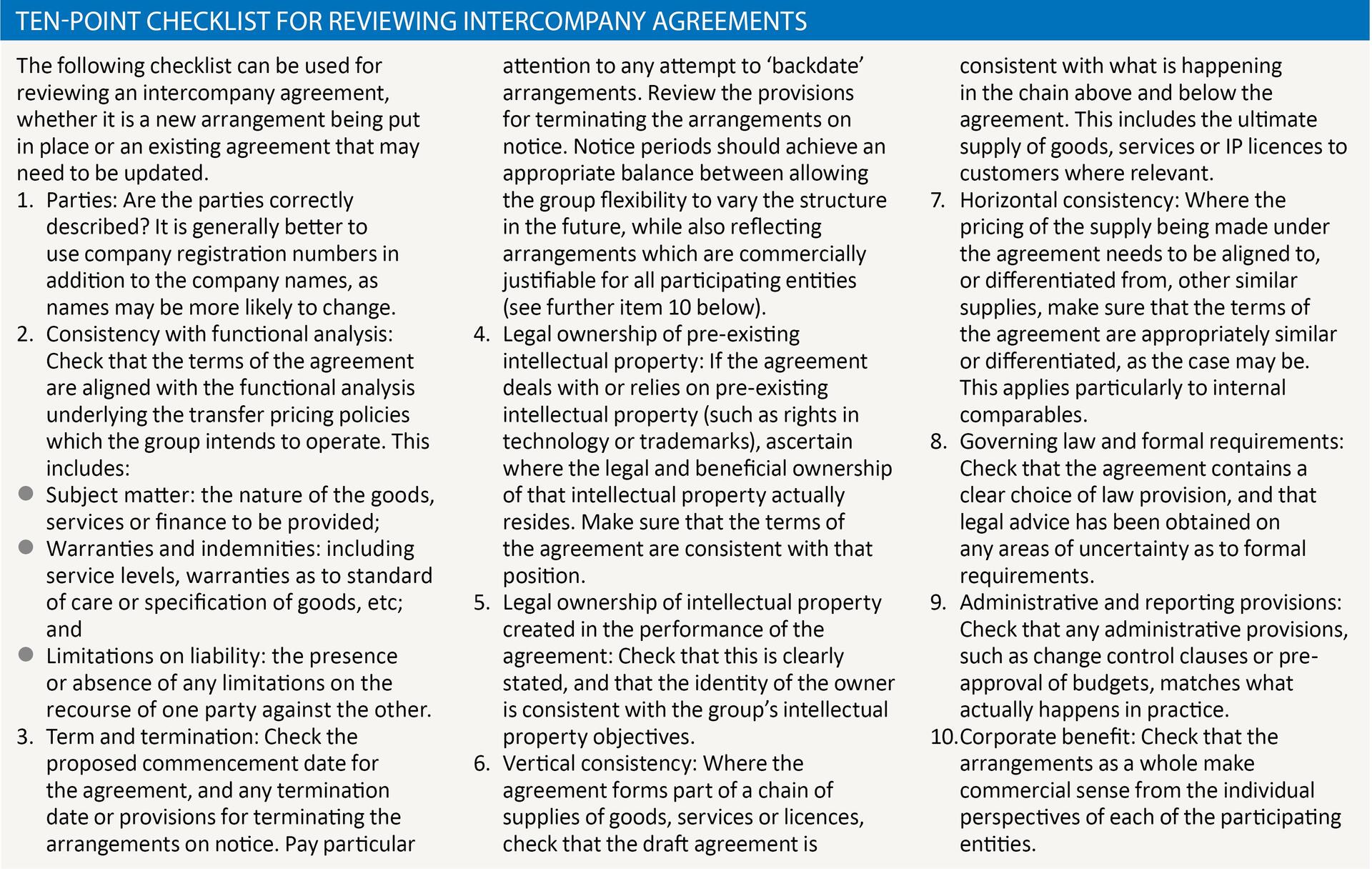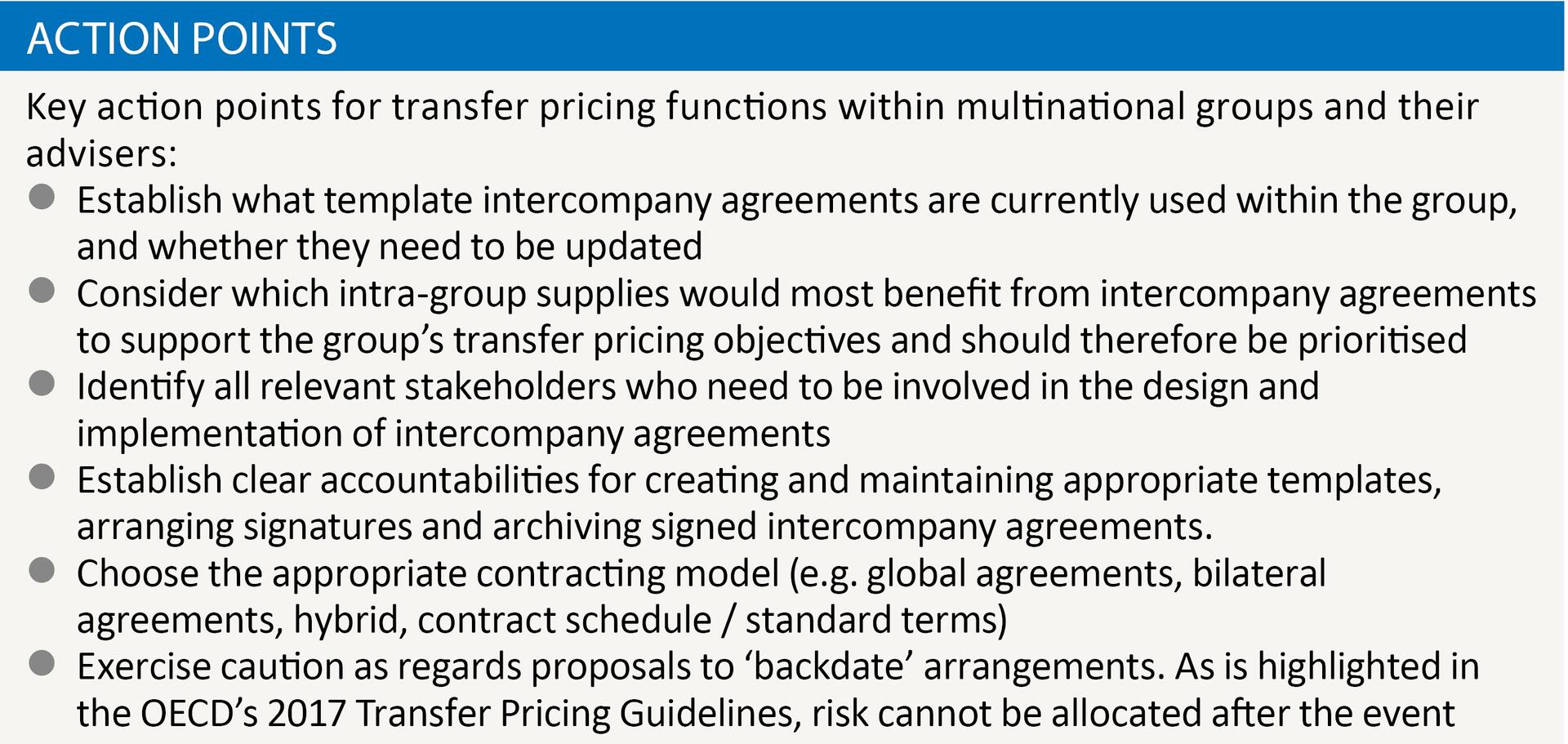Documenting it right

Paul Sutton provides guidance on what tax professionals should insist upon when documenting intercompany agreements for transfer pricing
Key Points
What is the issue?
Transfer pricing is widely regarded as one of the most significant and complex areas of tax risk affecting multinational groups. The recent case of Google highlights just how financially – and reputationally – damaging transfer pricing disputes can be.
What does it mean to me?
As with many areas of tax, transfer pricing is closely related to legal structures and the contractual terms upon which intra-group transactions are conducted. Groups which do not have appropriate, signed intercompany agreements in place are on the back foot in discussions with local tax authorities about their transfer pricing compliance.
What can I take away?
Putting in place and regularly updating intercompany agreements can seem like a complex and costly process. Failing to do so, however, is usually a false economy.
Transfer pricing is widely regarded as one of the most significant and complex areas of tax risk affecting multinational groups. It is also one of the main areas of focus for tax authorities and supranational organisations, such as the OECD. In 2016/17, the UK transfer pricing yield resulting from HMRC challenges was over £1.6 billion, nearly twice that of the previous year. The recent case of Google highlights just how financially – and reputationally – damaging transfer pricing disputes can be. The group has been embroiled in transfer pricing disputes for several years and recently made a €306m settlement with the Italian tax authorities, having previously settled with HMRC in the UK. Disputes are ongoing in France and Spain.
As with many areas of tax, transfer pricing is closely related to legal structures and the contractual terms upon which intra-group transactions are conducted. This has recently been underscored by the OECD in the latest edition of its Transfer Pricing Guidelines. The 2017 edition re-emphasises the fundamental importance of legal analysis and intercompany agreements as part of the resolution of transfer pricing issues. It is worth quoting verbatim what the 2017 guidelines say: ‘Importantly, ex ante contractual assumption of risk should provide clear evidence of a commitment to assume risk prior to the materialisation of risk outcomes. Such evidence is a very important part of the tax administration’s transfer pricing analysis of risks in commercial or financial relations, since, in practice, an audit performed by the tax administration may occur years after the making of such up-front decisions by the associated enterprises and when outcomes are known.’
Intercompany agreements (ICAs) are legal agreements between related parties. They define the legal terms on which services, products and financial support are provided within a group. ICAs can cover a wide range of matters, including head and back office services, revenue and cost sharing, intellectual property licences, and so on. The value of ICAs, like many compliance documents, often only becomes apparent when a group is required to respond to a tax or regulatory audit at short notice. Businesses frequently take the view that the relationship between corporate entities in a group is unlikely to come under scrutiny and so neglect to invest in clear, legally robust intercompany agreements. Even when such agreements do exist, they are often badly drafted, incomprehensible and out-of-date, so that they do not reflect the commercial reality of how the group operates. It is therefore beholden on tax advisers to international groups to ensure that legally binding intercompany agreements are in place and any transfer pricing risks minimised. Failing to do so is akin to giving tax authorities access to the group’s bank accounts so they can withdraw what they consider fair. The consequences of not having ICAs can be serious. Fundamentally, groups which do not have appropriate, signed ICAs in place are on the back foot in discussions with local tax authorities about their transfer pricing compliance. This is because they are unable to present a clear statement as to what intra-group supplies are being made (and for what price), how relevant assets are held, and how risks are allocated between group companies. In certain jurisdictions, corporates are routinely subject to fines and penalties, simply for failing to produce signed ICAs when requested. Other problems include expenses potentially being disallowed, post year-end ‘true up’ type adjustments being subject to challenge and local tax authorities attempting to re-characterise a transaction as something other than that claimed by the taxpayer.
While the tax reasons for properly drafted intercompany agreements are compelling enough, there are strong non-tax drivers, too. ICAs can be an important tool for regulatory compliance (such as complying with the new General Data Protection Regulation, or where one or more members of the group are regulated entities in the financial services and insurance sectors); ring-fencing assets and liabilities from risk; improving the corporate governance of companies throughout the group; reducing personal liability risks for directors; supporting the external and internal audit of group entities and ensuring that intellectual property rights can be enforced and monetised appropriately.
When putting together intercompany agreements of transfer pricing, tax advisers should bear in mind the following:
- If systems for creating and maintaining intercompany agreements are not established on a holistic, cross-functional basis, there is a high risk that different functions within a group will create contradictory sets of documentation which do not take into account the needs of all stakeholders. Tax advisers should therefore urge their clients to ensure that all relevant stakeholders are involved in the creation and maintenance of intercompany agreements.
- It is important to achieve the governance and transfer pricing benefits of having robust legal documentation for intra-group supplies. In relation to any given intra-group supply, the relevant intercompany agreements obviously need to be consistent with the group’s transfer pricing policies as regards the nature of the supply, the terms of supply (including the allocation of risk) and the pricing of the supply. They also need to be consistent with the reality of how the arrangements are operated and managed in practice. Complicated change control or reporting provisions which have been imported from an arms’ length commercial contract will do nothing to enhance a group’s transfer pricing position if they are not followed in practice.
- The terms of the intercompany agreements must be consistent with the legal and beneficial ownership of any relevant assets and the commercial reality of intra-group transactions. For example, an intra-group agreement where a company purports to grant a license over intellectual property which it does not actually own, may be likely to create confusion and misleading accounting entries, rather than promoting the group’s transfer pricing and other commercial objectives.
- The legal agreements should reflect an arrangement which the directors of each participating company can properly approve as promoting the interests of that particular company. This means that some proposed arrangements can be problematic – such as arrangements which would involve a particular entity incurring ongoing losses; being exposed to liabilities or cashflow demands which it does not have the financial resources to meet (such as indemnities for product liability, or an obligation to repay loans on demand); or ‘giving away’ assets or value, especially if it is to a parent undertaking. Although these considerations should be addressed in the functional and economic analysis required for transfer pricing, often they are not.
- Finally, the intercompany agreements must be capable of being legally binding, which means that the key terms of the arrangement must have ‘legal certainty’. This principally applies to the description of what is being supplied and the price of the supply, so that those provisions must be objectively ascertainable from the terms of the agreement. We see a lot of intercompany agreements where there is no price stated or the price is set by some vague reference to comparable turnover or net profits of the subsidiary. This approach can raise issues from the point of view of legal certainty and from a transfer pricing compliance perspective. Other common mistakes include agreements being too complicated; not matching ownership and flow of IP; not adequately reflecting group structures; failing to guard against inappropriate termination provisions; and overlooking the importance of making provisions for allocation of cost between multiple service recipients.

Conclusion
The OECD’s Transfer Pricing Guidelines are primarily intended to help tax administrations and multinational enterprises resolve transfer pricing ‘cases’, and to provide a common framework for tax administrations to adopt.
The task facing multinational enterprises is different: it is to design, implement and maintain appropriate corporate structures, effective ICA terms and ongoing systems to facilitate continuing transfer pricing compliance. It is also important that those structures and systems should support not only the group’s transfer pricing compliance objectives, but should also meet its commercial, regulatory and corporate governance needs. This means that a holistic, cross-functional approach is essential.
Putting in place and regularly updating intercompany agreements can seem like a complex and costly process. Failing to do so, however, is usually a false economy. Intercompany agreements do not have to be complicated – in fact they need to be simple so that stakeholders fully understand them – but, like anything else, they need to be properly planned and implemented, and supported by appropriate ongoing systems.



